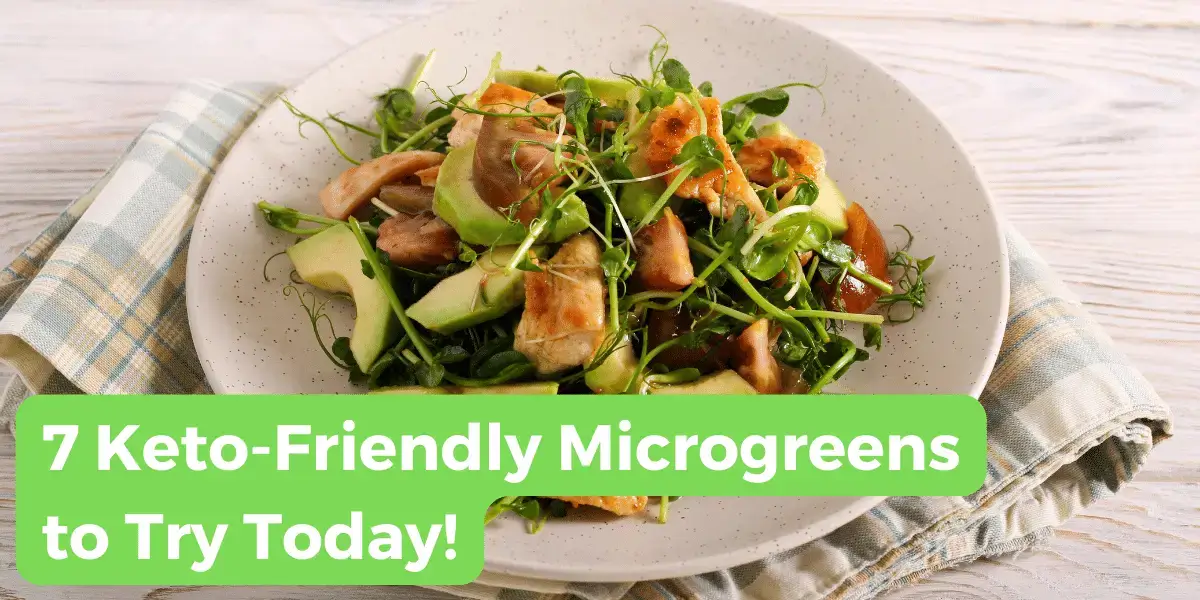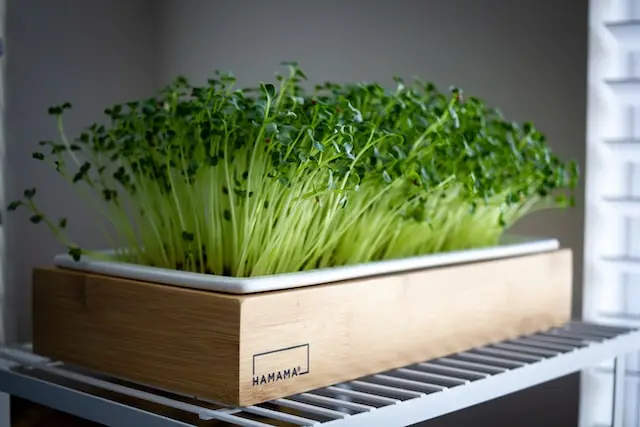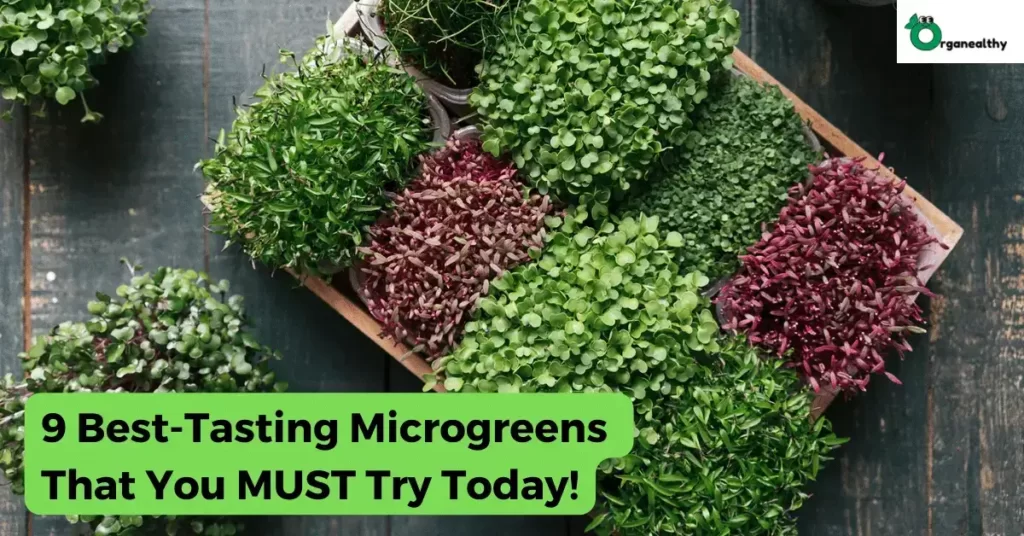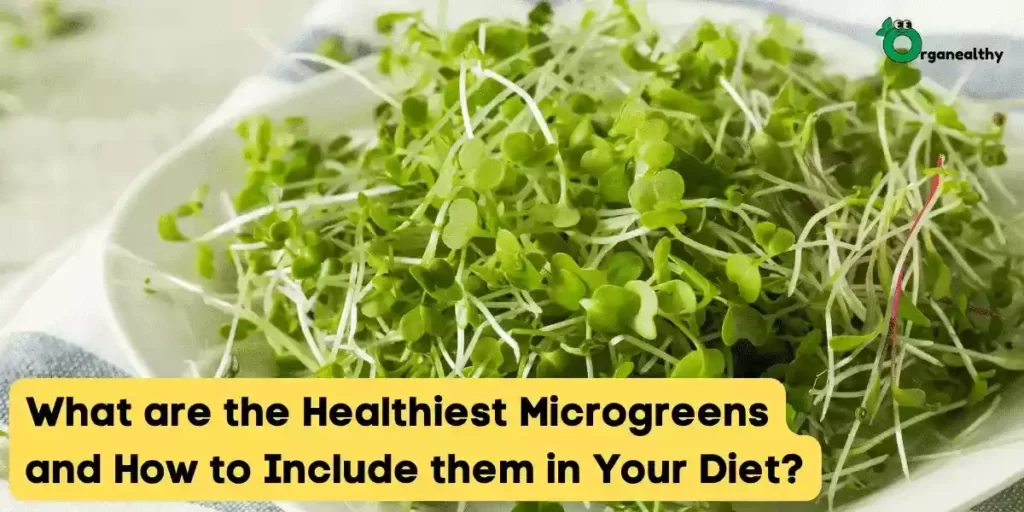Are microgreens keto-friendly? Yes, they are.
Microgreens are keto-friendly because they are low in carbohydrates but high in proteins, vitamins, and other essential minerals – making them a delicious addition to your keto diet plan.
If you are on a weight-loss journey, you are probably exploring some keto options to add to your daily diet.
Microgreens are popularly called “superfoods” because of their high nutritional density. According to studies, microgreens have 40 times more nutrients than their mature counterparts.
If you need a quick answer to which microgreens you should try – go for broccoli, radish, lettuce, or cabbage microgreens.
But wait, there are more. In this article, you will discover the 7 best microgreens for a ketogenic diet!
Let’s jump in.

What is a Keto Diet?
Considering you are reading this article, you already know what a keto diet is. However, here’s a brief refresher.
A ketogenic diet focuses on foods with low carbohydrates but high fats and proteins.
Essentially, your body breaks down carbohydrates to produce energy that your body runs on.
However, when you lower the carb supply, your body starts breaking down fat and protein to fuel your body; this process is known as ketosis.
Ketosis can also be defined as re-orienting your metabolism to efficiently and preferentially run on fats and ketones for energy.
Hence, your gym trainer has asked you to cut down on sugary stuff!
Why Microgreens Are Keto-Friendly?
If you’re still pondering about “are microgreens keto-friendly?”
Then let’s discuss this at length.
Microgreens are harvested at a very early stage – within 10 to 14 days – and thus, their nutritional density is HIGHER than the mature vegetables.
Vegetables lose their nutritional density as they mature.
Microgreens have a ton of nutrients like Vitamins E, C, and K. Even iron, potassium, zinc, and other such materials.
Microgreens are low in carbohydrates and are rich in protein and fat, which makes them highly ketogenic.
A study conducted at the University of Maryland calculated the nutritional components of multiple microgreens.
The study mentioned that red cabbage microgreens had 6X more Vitamin C and 40X more Vitamin E than mature red cabbage.
Also, they noted that cilantro microgreens possessed 3X more beta-carotene than mature cilantro.
Another study published in the Journal of Agricultural and Food Chemistry discovered that green daikon radish microgreens, garnet amaranth, and red cabbage possessed the highest levels of vitamins E, K, and C among the 25 different microgreens studied.
7 Keto-Friendly Microgreens to Try Today
If you are serious about getting in shape, following a keto diet along with your gym workout is a good start.
You should AVOID high-carb food like sugar, pastries, and white bread as these items pump a lot of carbs into your body and hinder your body’s ketosis process.
Instead, move on to something keto-friendly such as microgreens, seafood, and low-carb vegetables like broccoli and cauliflower.
Since we’re talking strictly about microgreens here, let’s jump straight to the 7 best keto-friendly microgreens.

Broccoli
Broccoli microgreens are one of the most popular microgreens. In fact, they are the most sold variety of microgreens – they have a market share of 25%!
One of the healthiest microgreens out there, broccoli microgreens are full of vitamins A, B, C, and K and also include a good amount of phosphorous, magnesium, and iron.
Broccoli microgreens have high levels of antioxidants that are beneficial for many heart/diabetes/cancer patients.
Cabbage
Cabbage microgreens are one of the most vibrant varieties of microgreens you can have on your plate – especially red cabbage microgreens.
According to studies, red cabbage microgreens are highly concentrated with vitamins C, A, E, and K1. If you want to follow a healthy keto diet, you need to consume foods with beta-carotene, potassium, and iron.
Cabbage microgreens are filled with these nutrients and minerals.
A study report published on the American Chemical Society about the effects of mature red cabbage and red cabbage microgreens on obese mice – who had a high risk of cardiovascular disease.
The study confirmed that microgreens led to reduced weight and liver cholesterol.
So, are microgreens keto-friendly? Yes, cabbage microgreens definitely are.
Radish
You must have tasted mature radish bulbs, right?
Radish microgreens taste just as peppery as the mature radish bulb – but with more freshness and crunch.
If you want to add spice, texture, and color to your microgreens salad, definitely add radish microgreens to it.
If not salads, add them to your sandwiches and add that touch of organic healthiness to your meals.
Various varieties of radishes, such as green daikon radish, china rose radish, and opal radish, are a high source of vitamins K, C, E, and Beta Carotene. (Journal of Agriculture and Food Chemistry)
Here’s our complete guide on radish microgreens if you want to know more about them.
Arugula
Arugula falls in the brassica family of vegetables and has high levels of minerals and vitamin A.
Arugula microgreens test the best when consumed raw as salad toppings. Its unique zesty, nutty, and bitter flavor makes it one of the most loved varieties of microgreens.
These delicious microgreens are filled with fiber, phytochemicals, calcium, potassium, folate, and important vitamins (A, C, and K).
Arugula is known to be one of the most nutritionally dense varieties of microgreens and even has cancer-fighting agents. (National Center for Biotechnology Information)
Lettuce
If you are eating to lose weight, you are probably already consuming a lot of lettuce. Ever wondered how they taste in microgreen form?
Lettuce comes in various varieties; some of the most popular ones are head, leaf, romaine, and celtuce.
You can try any variety you like. The texture is raw and crisp, just like mature lettuce. They taste slightly sweeter than the other microgreens we discussed above.
Lettuce microgreens are rich in nutrients and can be used in various dishes – salads, wraps, and sandwiches.
Amaranth
Do you eat quinoa?
Amaranth microgreens come under the same family – Amaranthaceae.
(Did you know that?!)
Veggies from this family are eaten for their leaves and seeds. One of the most peculiar qualities of amaranth is its balanced nutritional composition.
This means a balanced composition of minerals like calcium, iron, magnesium, and vitamins like A, B, and C. Likewise, amaranth microgreens are also filled with antioxidants, a little more than kale microgreens.
If you ever want to grow microgreens at home, then amaranth seeds are easily available and one of the cheapest ones.
Swiss Chard
Swiss chards are closely related to beet and spinach – and hence, taste similar to them. Swiss chard microgreens are gluten-free and filled with nutritional benefits.
Researchers observed that swiss chard microgreens contain a high amount of antioxidants, including tocopherols, carotenoids, and hydrophilic phenols.
Chards, along with kale, have high lutein components. Lutein is an antioxidant that is critical in protecting your skin and eyes.
Also, these greens are filled with zeaxanthin, which is an essential element in reducing the risk of macular degeneration, according to the American Macular Degeneration Foundation.
Along with being keto-friendly, swiss chard microgreens offer other health benefits, including:
- Better digestion
- Prevents diabetes and high blood pressure
- Lower the risks of chronic diseases like cancer
Note: Studies about microgreens are limited. It is recommended to consult a medical professional before consuming any microgreens.
Frequently Asked Questions
Why Follow a Keto Diet?
The Keto diet is mainly popular among those who want to lose weight or cut down on their carbs.
A keto diet can also help you manage medical conditions like epilepsy, brain disease, heart disease, and acne.
Who Should Avoid a Keto Diet?
Some people should avoid the keto diet, like those who are suffering from type-1 diabetes, as the keto diet might adversely affect their already low sugar levels.
Do Microgreens Have Carbs?
Yes, microgreens are low on carbohydrates as they are harvested during the cotyledon stage.
During this stage, the cotyledon cells in the seed leaves use stored carbohydrates to metabolize for energy, and it does so till the carbohydrates are completely exhausted.
Thus, making microgreens an extremely low-carb, keto-friendly food.
Are Broccoli Microgreens Keto-Friendly?
Broccoli microgreens, like any other microgreens, are packed with nutrients. They have a lot of fiber and protein and very few calories making them perfect for a keto diet.
They are low in carbohydrates, aren’t sweet, and are exactly what you need to look for in a keto diet.
Major Takeaways
You hopped onto this article with a question – are microgreens keto-friendly?
And you have got your answer!
Microgreens are not just highly nutritious superfoods but have superb health benefits. And one of them is – they help you lose weight.
Stop spending money on processed supplement powders that are marketed as “weight-loss supplements”, and instead spend on an organic, healthy, and cheap alternative – MICROGREENS!
So, what are you waiting for? Grab these delicious microgreens from your closest supermarket and drop them on your plates.






